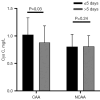Value of cystatin C for Kawasaki disease with coronary artery aneurysm
- PMID: 40386375
- PMCID: PMC12079684
- DOI: 10.21037/tp-2024-516
Value of cystatin C for Kawasaki disease with coronary artery aneurysm
Abstract
Background: Cardiovascular and kidney diseases are interconnected through shared biological mechanisms. However, research on renal function in Kawasaki disease (KD) remains insufficient. This study focused on coronary artery aneurysm (CAA), a severe cardiac consequence of KD, aiming to examine the predictive value of cystatin C (Cys C) and other common laboratory indicators before and after intravenous immunoglobulin (IVIG) treatment on KD with CAA.
Methods: Based on patients' coronary status, 122 KD individuals were categorized in this retrospective analysis. After comparing the clinical and laboratory information of the patients with KD, multivariate logistic regression analysis was employed to identify independent risk factors for CAA development among them. Additionally, the predictive values of these parameters in CAA development of KD were assessed by receiver operating characteristic (ROC) curves.
Results: In this study, 28 patients (23.0%, 28/122) had CAA, including 12 who had coronary artery regression (9.8%, 12/122). The parameters with P<0.10 in the difference analysis, namely polymorphous exanthem, changes in the extremities, plateletocrit and Cys C before IVIG, prealbumin >107.2 mg/L and prognostic nutritional index >54.7 after IVIG, were included in multivariate logistic regression analysis. Finally, binary logistic regression analysis identified the pre-IVIG Cys C [odds ratio, 10.183; 95% confidence interval (CI): 1.158-89.525] as an independent risk factor for developing CAA among KD patients. In addition, the 0.71 Cys C cut-off value sampled within five days had a 100% sensitivity and a 42.9% specificity (area under the ROC curve =0.752, 95% CI: 0.577-0.928, P=0.03).
Conclusions: Higher pre-IVIG Cys C levels may be associated with increased CAA risk, but further large-scale prospective studies are needed to confirm its predictive utility. Furthermore, Cys C acquired within five days of disease onset may theoretically provide better prediction power for the CAA development in KD.
Keywords: Kawasaki disease (KD); coronary artery aneurysm (CAA); cystatin C (Cys C); predictive value.
Copyright © 2025 AME Publishing Company. All rights reserved.
Conflict of interest statement
Conflicts of Interest: All authors have completed the ICMJE uniform disclosure form (available at https://tp.amegroups.com/article/view/10.21037/tp-2024-516/coif). Y.P. received fundings from the Guangxi Medical and Health Key Discipline Construction Project [No. 2019 (19)] and Guangxi Clinical Research Center for Pediatric Disease (No. GUI KE AD22035219). The other authors have no conflicts of interest to declare.
Figures



Similar articles
-
Prognostic nutritional index value in the prognosis of Kawasaki disease with coronary artery lesions.Front Nutr. 2023 Feb 1;10:1075619. doi: 10.3389/fnut.2023.1075619. eCollection 2023. Front Nutr. 2023. PMID: 36819679 Free PMC article.
-
Evaluation of laboratory predictors for intravenous immunoglobulin resistance and coronary artery aneurysm in Kawasaki Disease before and after therapy.Clin Rheumatol. 2023 Jan;42(1):167-177. doi: 10.1007/s10067-022-06366-x. Epub 2022 Sep 21. Clin Rheumatol. 2023. PMID: 36129563 Free PMC article.
-
Risk Factors for Resistance to Intravenous Immunoglobulin Treatment and Coronary Artery Abnormalities in a Chinese Pediatric Population With Kawasaki Disease: A Retrospective Cohort Study.Front Pediatr. 2022 Apr 20;10:812644. doi: 10.3389/fped.2022.812644. eCollection 2022. Front Pediatr. 2022. PMID: 35515347 Free PMC article.
-
Risk Factors of Coronary Artery Abnormality in Children With Kawasaki Disease: A Systematic Review and Meta-Analysis.Front Pediatr. 2019 Sep 26;7:374. doi: 10.3389/fped.2019.00374. eCollection 2019. Front Pediatr. 2019. PMID: 31612117 Free PMC article.
-
Dissecting Kawasaki disease: a state-of-the-art review.Eur J Pediatr. 2017 Aug;176(8):995-1009. doi: 10.1007/s00431-017-2937-5. Epub 2017 Jun 27. Eur J Pediatr. 2017. PMID: 28656474 Free PMC article. Review.
References
LinkOut - more resources
Full Text Sources
Research Materials
